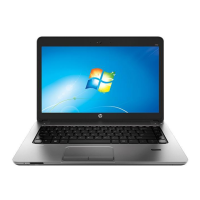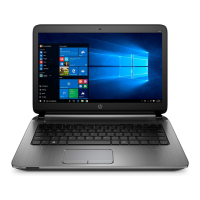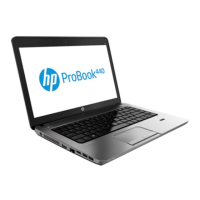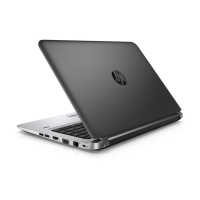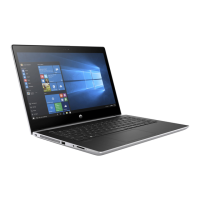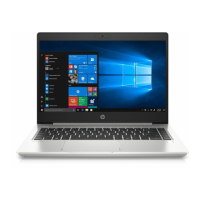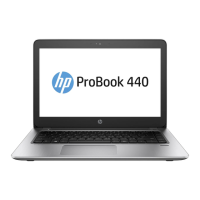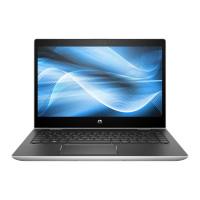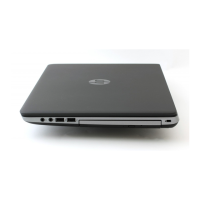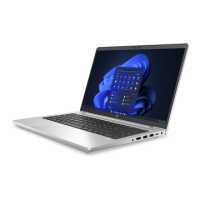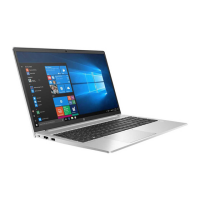Do you have a question about the HP ProBook 440 G8 and is the answer not in the manual?
Details components on the right side of the computer, including ports and indicators.
Details components on the left side of the computer, including security slot and network jack.
Identifies and describes display components such as antennas, cameras, and microphones.
Discusses keyboard variations and features like special keys and hot keys.
Explains touchpad settings, adjustments, and components like control zones.
Describes various indicator lights on the computer and their meanings.
Details the power button, speakers, and fingerprint reader locations and functions.
Lists and describes special keys like Esc, Fn, and Windows keys on the keyboard.
Explains combinations of Fn key with other keys for system functions.
Identifies components located on the bottom of the computer.
Identifies components located on the rear of the computer.
Explains the purpose and location of various labels on the computer.
Identifies main computer components and their spare part numbers.
Lists and describes the subcomponents of the display assembly.
Details the contents and spare part number for the cable kit.
Lists various miscellaneous parts and their spare part numbers.
Lists the necessary tools for performing removal and replacement procedures.
Provides important considerations before and during disassembly and assembly.
Warns about handling plastic parts during disassembly to prevent damage.
Advises on careful handling of cables and connectors to avoid damage.
Provides guidelines for handling storage drives safely.
Explains the risks of ESD and precautions to prevent component damage.
Discusses how static electricity is generated and factors affecting it.
Details precautions for preventing ESD damage to electronic components.
Describes methods and equipment for grounding to prevent static discharge.
Provides precautions for properly grounding the work area.
Lists recommended materials and equipment for preventing static electricity.
Offers guidelines for safely packaging and transporting equipment.
Outlines procedures for removing and replacing computer components.
Details steps required before starting the disassembly process.
Provides instructions for removing the bottom cover of the computer.
Details the procedure for removing and replacing the computer battery.
Explains how to remove and install memory modules.
Provides instructions for removing and replacing the WLAN module.
Details the process for removing and replacing the WWAN module.
Describes how to remove and install the M.2 solid-state drive.
Explains the procedure for removing the Real-Time Clock (RTC) battery.
Details the steps for removing and installing the I/O board.
Provides instructions for removing and reinstalling the touchpad.
Explains how to remove and replace the computer's fan assembly.
Details the removal and replacement process for the fingerprint reader board.
Provides instructions for removing and installing the heat sink.
Outlines the procedure for removing and installing the system board.
Details the steps for removing and reinstalling the computer speaker.
Explains how to remove and replace the power connector cable.
Covers the removal and disassembly of the display assembly.
Describes the removal of the top cover with keyboard.
Explains how to access and navigate the Computer Setup (BIOS) utility.
Details methods for navigating and making selections within Computer Setup.
Provides steps to return Computer Setup settings to factory defaults.
Covers information on how to update the BIOS for the computer.
Explains how to find the current BIOS version on the computer.
Lists prerequisites and important steps before updating the BIOS.
Details the steps for installing a downloaded BIOS update.
Explains how to change the boot device order during startup.
Discusses how to modify Trusted Platform Module (TPM) settings in BIOS.
Describes HP Sure Start technology for BIOS protection and restoration.
Covers methods for backing up data and creating recovery media.
Explains how to use Windows built-in tools for backing up personal information.
Details using the HP Cloud Recovery tool to create bootable recovery media.
Discusses various tools and methods for system recovery.
Explains how to create restore points for system recovery.
Lists and describes different methods for restoring and recovering the system.
Guides on how to recover the system using HP Recovery media.
Explains how to change boot order to start from recovery media.
Details HP Sure Recover, a system OS recovery solution.
Describes using the Windows-based utility for hardware diagnostics.
Explains how to use a failure ID code generated by the diagnostics tool.
Details how to access the diagnostics tool from HP support options.
Provides steps to access the diagnostics tool via HP Help and Support.
Explains how to access the diagnostics tool via HP Support Assistant.
Details how to launch the diagnostics tool from the Windows Start menu.
Guides on downloading the HP PC Hardware Diagnostics Windows tool.
Provides instructions for installing the downloaded diagnostics tool.
Explains how to use the UEFI version of the hardware diagnostics tool.
Details the procedure to start the HP PC Hardware Diagnostics UEFI tool.
Describes configuring settings for remote UEFI diagnostics.
Guides on downloading the remote UEFI diagnostics tool.
Explains how to customize remote UEFI diagnostic settings.
Lists overall computer specifications like dimensions, weight, and power.
Provides detailed specifications for the computer's display.
Details specifications for different capacities of solid-state drives.
Details steps to restore nonvolatile memory to its factory state.
Addresses common questions regarding nonvolatile memory and BIOS.
Outlines general power cord set requirements applicable globally.
Lists power cord requirements specific to different countries and regions.
Details components on the right side of the computer, including ports and indicators.
Details components on the left side of the computer, including security slot and network jack.
Identifies and describes display components such as antennas, cameras, and microphones.
Discusses keyboard variations and features like special keys and hot keys.
Explains touchpad settings, adjustments, and components like control zones.
Describes various indicator lights on the computer and their meanings.
Details the power button, speakers, and fingerprint reader locations and functions.
Lists and describes special keys like Esc, Fn, and Windows keys on the keyboard.
Explains combinations of Fn key with other keys for system functions.
Identifies components located on the bottom of the computer.
Identifies components located on the rear of the computer.
Explains the purpose and location of various labels on the computer.
Identifies main computer components and their spare part numbers.
Lists and describes the subcomponents of the display assembly.
Details the contents and spare part number for the cable kit.
Lists various miscellaneous parts and their spare part numbers.
Lists the necessary tools for performing removal and replacement procedures.
Provides important considerations before and during disassembly and assembly.
Warns about handling plastic parts during disassembly to prevent damage.
Advises on careful handling of cables and connectors to avoid damage.
Provides guidelines for handling storage drives safely.
Explains the risks of ESD and precautions to prevent component damage.
Discusses how static electricity is generated and factors affecting it.
Details precautions for preventing ESD damage to electronic components.
Describes methods and equipment for grounding to prevent static discharge.
Provides precautions for properly grounding the work area.
Lists recommended materials and equipment for preventing static electricity.
Offers guidelines for safely packaging and transporting equipment.
Outlines procedures for removing and replacing computer components.
Details steps required before starting the disassembly process.
Provides instructions for removing the bottom cover of the computer.
Details the procedure for removing and replacing the computer battery.
Explains how to remove and install memory modules.
Provides instructions for removing and replacing the WLAN module.
Details the process for removing and replacing the WWAN module.
Describes how to remove and install the M.2 solid-state drive.
Explains the procedure for removing the Real-Time Clock (RTC) battery.
Details the steps for removing and installing the I/O board.
Provides instructions for removing and reinstalling the touchpad.
Explains how to remove and replace the computer's fan assembly.
Details the removal and replacement process for the fingerprint reader board.
Provides instructions for removing and installing the heat sink.
Outlines the procedure for removing and installing the system board.
Details the steps for removing and reinstalling the computer speaker.
Explains how to remove and replace the power connector cable.
Covers the removal and disassembly of the display assembly.
Describes the removal of the top cover with keyboard.
Explains how to access and navigate the Computer Setup (BIOS) utility.
Details methods for navigating and making selections within Computer Setup.
Provides steps to return Computer Setup settings to factory defaults.
Covers information on how to update the BIOS for the computer.
Explains how to find the current BIOS version on the computer.
Lists prerequisites and important steps before updating the BIOS.
Details the steps for installing a downloaded BIOS update.
Explains how to change the boot device order during startup.
Discusses how to modify Trusted Platform Module (TPM) settings in BIOS.
Describes HP Sure Start technology for BIOS protection and restoration.
Covers methods for backing up data and creating recovery media.
Explains how to use Windows built-in tools for backing up personal information.
Details using the HP Cloud Recovery tool to create bootable recovery media.
Discusses various tools and methods for system recovery.
Explains how to create restore points for system recovery.
Lists and describes different methods for restoring and recovering the system.
Guides on how to recover the system using HP Recovery media.
Explains how to change boot order to start from recovery media.
Details HP Sure Recover, a system OS recovery solution.
Describes using the Windows-based utility for hardware diagnostics.
Explains how to use a failure ID code generated by the diagnostics tool.
Details how to access the diagnostics tool from HP support options.
Provides steps to access the diagnostics tool via HP Help and Support.
Explains how to access the diagnostics tool via HP Support Assistant.
Details how to launch the diagnostics tool from the Windows Start menu.
Guides on downloading the HP PC Hardware Diagnostics Windows tool.
Provides instructions for installing the downloaded diagnostics tool.
Explains how to use the UEFI version of the hardware diagnostics tool.
Details the procedure to start the HP PC Hardware Diagnostics UEFI tool.
Describes configuring settings for remote UEFI diagnostics.
Guides on downloading the remote UEFI diagnostics tool.
Explains how to customize remote UEFI diagnostic settings.
Lists overall computer specifications like dimensions, weight, and power.
Provides detailed specifications for the computer's display.
Details specifications for different capacities of solid-state drives.
Details steps to restore nonvolatile memory to its factory state.
Addresses common questions regarding nonvolatile memory and BIOS.
Outlines general power cord set requirements applicable globally.
Lists power cord requirements specific to different countries and regions.
| Camera | 720p HD camera |
|---|---|
| Dimensions | 32.19 x 21.39 x 1.99 cm |
| Processor | Intel Core i5-1135G7 |
| Display | 14-inch, FHD (1920 x 1080) |
| Graphics | Intel Iris Xe Graphics |
| Operating System | Windows 10 Pro |
| Battery | 3-cell, 45 Wh Li-ion |
| Weight | 1.38 kg |
| Ports | 1 x RJ-45, 1 x headphone/microphone combo |
| Wireless | Intel Wi-Fi 6 AX201 |
| Security | TPM 2.0, Fingerprint reader |
